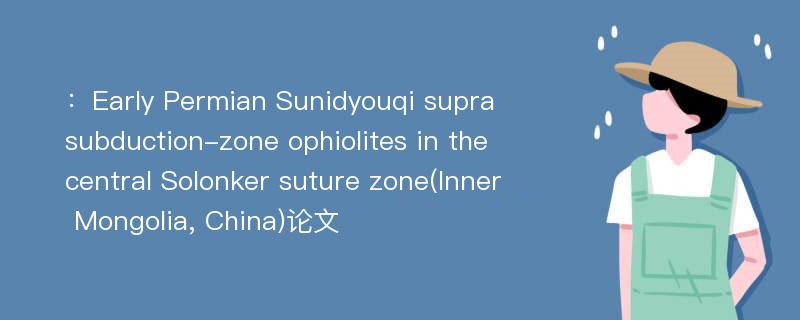
本文主要研究内容
作者(2019)在《Early Permian Sunidyouqi suprasubduction-zone ophiolites in the central Solonker suture zone(Inner Mongolia, China)》一文中研究指出:Different final closing ages have been proposed for the evolution of the Paleo-Asian Ocean(PAO),including Late Silurian, pre-Late Devonian, Early Permian, Late-Permian and Late Permian-Early Triassic.Ophiolites represent fragments of ancient oceanic crust and play an important role in identifying the suture zone and unveiling the evolutionary history of fossil oceans. Our detailed geological, geochemical and geochronological investigations argue for the existence of Early Permian(297 Ma) SSZ type ophiolites in the Sunidyouqi area of central Inner Mongolia, China. The gabbros and basalts show LREE depleted REE patterns and left-leaning primitive mantle-normalized spider diagrams with variable negative Nb-Ta anomalies(Nb~*= 0.24-1.28 and 0.29-0.55, respectively). The Sunidyouqi ophiolites were generated in a mature back-arc basin. The Sunidyouqi ophiolites share the same petrological,geochemical and geochronological characteristics with the other ophiolites along the Solonker suture zone, delineating a Late Paleozoic ocean and arc-trench system. This Late Paleozoic ocean and arc-trench system coincides with a Permian paleobiogeographical boundary, i.e. the boundary between the northern cold climate(Boreal faunal-Angaraland floral realm), and a southern warm climate(Tethys faunal-Cathaysian floral realm). A tectonic scenario was proposed at last for the closure of the SE PAO involving(1) Late Ordovician to Middle Permian continuous southward subduction beneath the northern margin of North China;(2) Carboniferous to Middle Permian continuous northward subduction the forming the Northern Accretionary Orogen;(3) Late Permian final closure of the SE PAO.
Abstract
Different final closing ages have been proposed for the evolution of the Paleo-Asian Ocean(PAO),including Late Silurian, pre-Late Devonian, Early Permian, Late-Permian and Late Permian-Early Triassic.Ophiolites represent fragments of ancient oceanic crust and play an important role in identifying the suture zone and unveiling the evolutionary history of fossil oceans. Our detailed geological, geochemical and geochronological investigations argue for the existence of Early Permian(297 Ma) SSZ type ophiolites in the Sunidyouqi area of central Inner Mongolia, China. The gabbros and basalts show LREE depleted REE patterns and left-leaning primitive mantle-normalized spider diagrams with variable negative Nb-Ta anomalies(Nb~*= 0.24-1.28 and 0.29-0.55, respectively). The Sunidyouqi ophiolites were generated in a mature back-arc basin. The Sunidyouqi ophiolites share the same petrological,geochemical and geochronological characteristics with the other ophiolites along the Solonker suture zone, delineating a Late Paleozoic ocean and arc-trench system. This Late Paleozoic ocean and arc-trench system coincides with a Permian paleobiogeographical boundary, i.e. the boundary between the northern cold climate(Boreal faunal-Angaraland floral realm), and a southern warm climate(Tethys faunal-Cathaysian floral realm). A tectonic scenario was proposed at last for the closure of the SE PAO involving(1) Late Ordovician to Middle Permian continuous southward subduction beneath the northern margin of North China;(2) Carboniferous to Middle Permian continuous northward subduction the forming the Northern Accretionary Orogen;(3) Late Permian final closure of the SE PAO.
论文参考文献
论文详细介绍
论文作者分别是来自Geoscience Frontiers的,发表于刊物Geoscience Frontiers2019年03期论文,是一篇关于,Geoscience Frontiers2019年03期论文的文章。本文可供学术参考使用,各位学者可以免费参考阅读下载,文章观点不代表本站观点,资料来自Geoscience Frontiers2019年03期论文网站,若本站收录的文献无意侵犯了您的著作版权,请联系我们删除。
